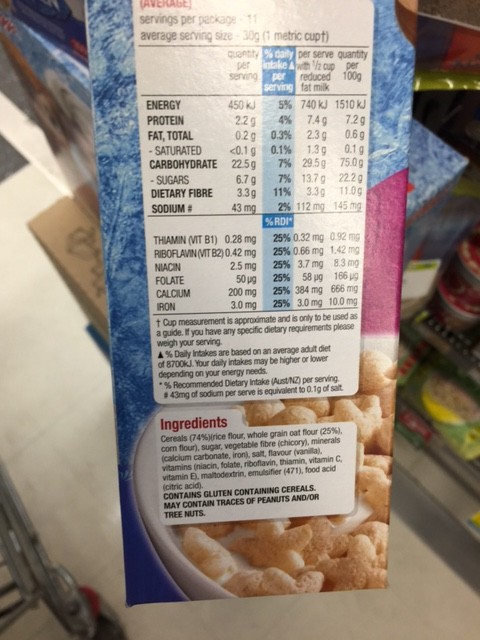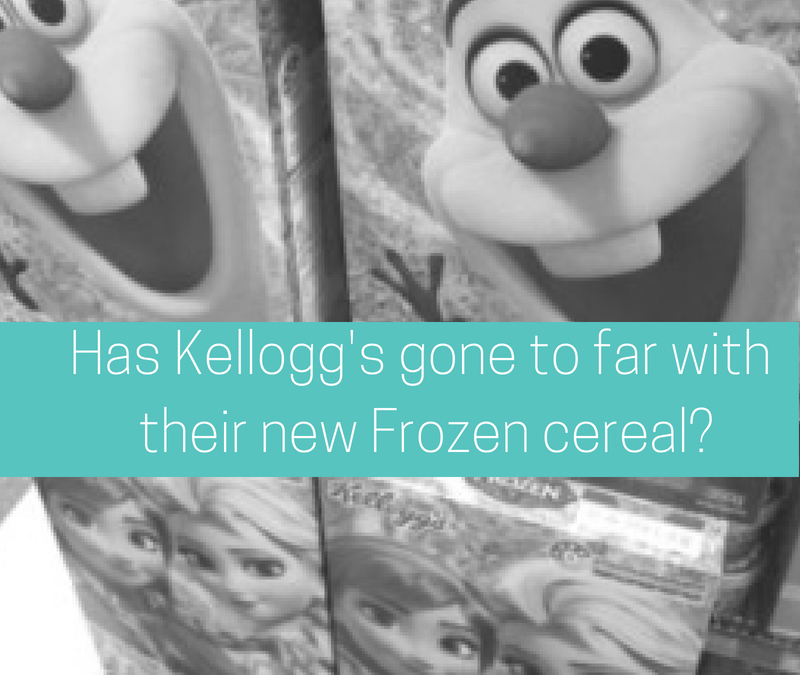Frozen Cereal
This morning I visited the local supermarket with twins in tow. This is a very rare occurrence. I normally avoid taking any children with me to the supermarket. However, I needed to pick up a few last minute items for the weekend for a special Father’s day breakfast.
As we were going up and down a few of the aisles, the twins emphatically pointed out to me that they had seen Frozen! The positioning of this product was right at eye level for my toddlers! There was no way they weren’t going to see this! I wasn’t even sure what this was!
Presentation of packaging
Look at the packaging! in the bottom corner, there is a little cereal bowl. Upon closer inspection I could see that this cereal was frozen theme shapes! It was a new cereal- Kellogg’s Frozen cereal.
Healthy star rating – 4 stars!
The next thing that grabbed my attention was the Healthy Star rating – 4 stars!
I would assume that is pretty high for your average sugary breakfast cereal?
Now I was intrigued, lets look at the ingredients! The Health Star Rating system has been designed as a front of pack labelling system that helps consumers choose easily, quickly and in a standard way between packaged products.
The higher the rating, the healthier the choice.
Wow, 4 stars, I got excited, perhaps Kellogg’s had released a new product that appealed to kids and was healthy too!
Ingredients
I was intrigued to see the ingredients! Could it possibly be? A healthy cereal?
74% of the product is cereal based (rice, whole grain oat flour, corn flour).
What is the rest of the product made up of?
The next ingredient on the label is sugar.
The order in which ingredients appear on an ingredients label is important.
This tells me that the next largest ingredient after the cereals is sugar. This isn’t unusual for a breakfast cereal though!
The ingredients that captured my attention were Maltodextrin and Citric acid.

What is maltodextrin?
Maltodextrin is an additive often used in products as a bulking agent, a thickener to bulk up foods. Maltodextrin is obtained by the hydrolysis of starch. Generally from corn, rice or potato starch, sometimes even wheat. The starch is cooked (normally with water) and then acids or enzymes are added so it breaks down even further, until it results in a white powder. Even though it is derived from natural sources it is a highly processed product.
Free Glutamic Acid
Maltodextrin often contains or produces processed free glutamic acid.
I hear you asking so what? Free glutamates do occur naturally in many foods.
If you aren’t allergic or intolerant to MSG, eating MSG at these quantities isn’t an issue.
At normal levels in our system glutamates allow cells in the brain to communicate with each other.
The issue is when excessive amounts are consumed, the brain cells die.
In these normal foods that contain free glutamate, different amino acids compete to get into the brain, so only a little enters the brain.
Manufacturers have worked out that MSG can be produced from any food protein by hydrolysing vegetable proteins, wheat proteins, or milk protein.
These excessive amounts at much higher concentrations gets into the brain causing excitotoxic effects.
Potential symptoms
There are a range of symptoms that can be caused by those that are sensitive to MSG, these include:
- dizziness
- headaches
- irritability
- nausea
- pins and needles in upper limbs
- hives
If your child is sensitive to MSG I always recommend to my clients to AVOID maltodextrin.
Citric acid
Citric acid is made from the fermentation of molasses or from corn.
Citric acid often contains or produces processed free glutamic acid.
As mentioned above in relation to maltodextrin, this processed free glutamic acid can produce the same symptoms as MSG for those that are sensitive.
If your child is sensitive to MSG I always recommend to my clients to AVOID citric acid.
Conclusion
Food manufacturers will continue to target the vulnerable sector of our community – our children.
They are relying on the enticing packaging and product placement to pester their parents into buying this. I expect that Kellogg’s are hoping this will be a top selling cereal for them. How could it not be? It’s Frozen!
I personally wouldn’t buy Kellogg’s Frozen cereal for my children.
I would recommend that if your children are sensitive you should also avoid it. For the Healthy Star Rating to have any meaning to me as a consumer it needs to take into account the impact of additives on our health!
Check your pantry staples and let me know if you found any with maltodextrin or citric acid
If you would love to be additive free but it all seems too hard, too overwhelming and you just don’t know where to start, we can help you with a COMPLIMENTARTY 30 Min initial consult.
I make it easy for you and will provide you tips to get you started!



 My passion and mission is to work with families to reduce the overwhelm when going additive free. Moving to additive free living can bring back peace, calm and joy to families. I know it's possible and I've experienced it first hand with my 5 boys.
My passion and mission is to work with families to reduce the overwhelm when going additive free. Moving to additive free living can bring back peace, calm and joy to families. I know it's possible and I've experienced it first hand with my 5 boys.




Very interesting topic, but I am not that big on believing random people on the internet. Could you please post you sources?
Thank you!
Of course…www.truthinlabeling.org/hiddensources.html and Excitotoxins: The Taste That Kills, Dr Russell Blaylock (Neurosurgeon).
MSG is a sweet poison. All these big brands, for their self-profit use this toxic chemical which they will never use for their own family,
Try to get fresh food which is served fresh without any additives.
Definitely is a poison. Couldn’t agree more!